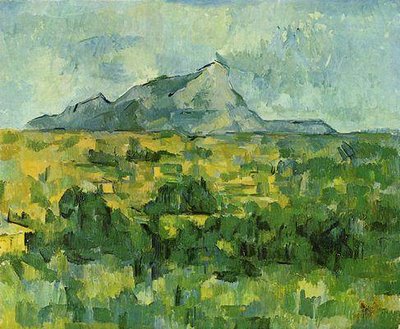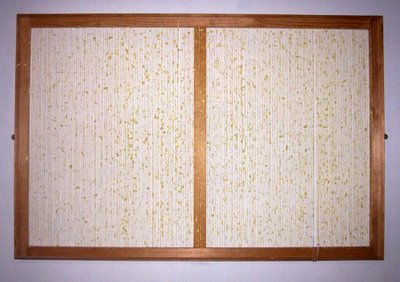
This blog's title is based upon the best question I ever overheard being asked, by a young Liverpudlian child to his mother, as in "What's..?". The answer seems to be something of a creative and cultural nature which, in deed (primarily the making of art) and word, this blog intends to explore...
Sunday, October 22, 2006
Cezanne
Today marks the centenary, to the very day, of the passing of Paul Cezanne, the father of modern painting & a great personal hero. I wasn't aware of the actual date (only the year) of his death until late last night, whilst watching the Phaidon video of Cezanne's life & work, loaned from the college library that has recently come to be the site of the latest day job. Towards the end of the film, a shot scans across the surface of his tombstone, revealing the death date as being 22 Octobre 1906, a scene I was watching shortly after the clock had ticked over past midnight into today: a most strange coincidence but fitting indeed. Here's an iconic image to mark the event.


Sunday, October 08, 2006
'Current' artwork
Recently took the opportunity to photograph one of my old-yet-still-most-recent pieces of art work in situ at a friend’s home. This work is now 5 – 6 years old, initiated within an academic environment, but still represents my most recent serious creative practice &, I believe, having recently(ish) read James Meyer’s ‘Minimalism: Art & Polemics in the 60s’ & refreshed my memory with some of the concerns & ideas that informed this small body of work-in-progress, might still provide scope for further exploration should circumstances ever allow.
Although still images are inadequate to properly describe the true nature of this piece, a selection of photos of it & some related work follow, & then some form of explanation into the ideas & intentions behind its making is included, being essentially a statement – which still probably provides the most cogent & appropriate exposition - accompanying the work as it appeared on my old personal website, now becalmed.






Next is another 'stringed' piece, this time with no paint applied to the threads, merely to the stretcher (this results in a particularly 'gossamery' surface effect when viewed actively), followed by a related work, this time utilising a grid of threads, the oil paint slathered thickly over the whole surface then allowed to fall through, some, obviously onto the stretcher.


This is the original statement - by no means new itself but still seeming relevant - accompanying the work.
“The following small body of work, to be regarded as proposals, sketches, for work yet to be made, comprises examples of the ideas informing the direction in which I intend my progressive practice to develop.
The objects are created with the intention of being 'moving pictures', combining drawing and painting in a three-dimensional form that emphasizes the physicality and facture of the work and demands an embodied, active participation of the spectator in the realisation of the 'work of art' and recognition of a shared physical presence in the world.
In formal terms, the objects draw on a modernist and minimalist vocabulary of simple line and grid structures which act as both drawing and the physical framework to which paint is applied (or not). The open nature of these structures allows the works to function three-dimensionally and explore possibilities beyond the surface, incorporating the wall upon which the objects are hung as an essential component of the work, as the 'screen' upon which shadows are projected and form part of the drawn/painted image.
As a full appreciation of this effect depends upon the spectator moving across the picture plane, causing an optical 'ripple' to pass over it in the case of the vertically strung works, or moving in more closely to observe the fall of the paint through the grid onto the stretcher behind in the other, gridded, instance, the physical space occupied by the object also extends in front of it into that of the spectator, setting up a dialogue between the former and the embodied consciousness of the latter, as would occur during the course of viewing a sculpture or other 3D object 'in the round'.
In each instance, process is essential to the creation of the work and recognition and understanding of the 'work of the work' which, in its reception, becomes an ongoing, unresolved aspect of each piece.
First, a stretcher was constructed and then a piece of canvas, as would usually be stretched over such a structure, was unpicked thread by thread before being stretched in the same manner, and 'rewoven' in the case of the grid piece. Thick, only slightly thinned oil paint was applied to either the canvas threads or the stretcher; spread evenly across the grid, upon which it either sat or fell through, or brushed, drawn, horizontally along the length of one of the vertically-strung pieces, where it would form random clumps, or similarly fall to sometimes link neighbouring threads.
These processes lead to works that combine, initially, strict order and then pure chance; two- and three-dimensionality as essential qualities of their nature; question the integrity of the picture plane whilst remaining pictorial in nature, and feature drawing and painting as both separate and conjoined aspects of their making and being.
It is intended that the vertically strung pieces will develop on a much wider, 'panoramic' scale, which seems a necessary condition of the full realization of the optical nature of their surface effects as 'moving pictures' enabling recognition of the viewer's embodied and temporal existence in physical space”.
Interesting to note that, given the recent photos taken & posted of that damaged wire fence, as ‘drawing in space’ (see previous post), my concerns do seem to have endured, despite a significant period of not-making artwork, certainly of this nature.
Although still images are inadequate to properly describe the true nature of this piece, a selection of photos of it & some related work follow, & then some form of explanation into the ideas & intentions behind its making is included, being essentially a statement – which still probably provides the most cogent & appropriate exposition - accompanying the work as it appeared on my old personal website, now becalmed.






Next is another 'stringed' piece, this time with no paint applied to the threads, merely to the stretcher (this results in a particularly 'gossamery' surface effect when viewed actively), followed by a related work, this time utilising a grid of threads, the oil paint slathered thickly over the whole surface then allowed to fall through, some, obviously onto the stretcher.


This is the original statement - by no means new itself but still seeming relevant - accompanying the work.
“The following small body of work, to be regarded as proposals, sketches, for work yet to be made, comprises examples of the ideas informing the direction in which I intend my progressive practice to develop.
The objects are created with the intention of being 'moving pictures', combining drawing and painting in a three-dimensional form that emphasizes the physicality and facture of the work and demands an embodied, active participation of the spectator in the realisation of the 'work of art' and recognition of a shared physical presence in the world.
In formal terms, the objects draw on a modernist and minimalist vocabulary of simple line and grid structures which act as both drawing and the physical framework to which paint is applied (or not). The open nature of these structures allows the works to function three-dimensionally and explore possibilities beyond the surface, incorporating the wall upon which the objects are hung as an essential component of the work, as the 'screen' upon which shadows are projected and form part of the drawn/painted image.
As a full appreciation of this effect depends upon the spectator moving across the picture plane, causing an optical 'ripple' to pass over it in the case of the vertically strung works, or moving in more closely to observe the fall of the paint through the grid onto the stretcher behind in the other, gridded, instance, the physical space occupied by the object also extends in front of it into that of the spectator, setting up a dialogue between the former and the embodied consciousness of the latter, as would occur during the course of viewing a sculpture or other 3D object 'in the round'.
In each instance, process is essential to the creation of the work and recognition and understanding of the 'work of the work' which, in its reception, becomes an ongoing, unresolved aspect of each piece.
First, a stretcher was constructed and then a piece of canvas, as would usually be stretched over such a structure, was unpicked thread by thread before being stretched in the same manner, and 'rewoven' in the case of the grid piece. Thick, only slightly thinned oil paint was applied to either the canvas threads or the stretcher; spread evenly across the grid, upon which it either sat or fell through, or brushed, drawn, horizontally along the length of one of the vertically-strung pieces, where it would form random clumps, or similarly fall to sometimes link neighbouring threads.
These processes lead to works that combine, initially, strict order and then pure chance; two- and three-dimensionality as essential qualities of their nature; question the integrity of the picture plane whilst remaining pictorial in nature, and feature drawing and painting as both separate and conjoined aspects of their making and being.
It is intended that the vertically strung pieces will develop on a much wider, 'panoramic' scale, which seems a necessary condition of the full realization of the optical nature of their surface effects as 'moving pictures' enabling recognition of the viewer's embodied and temporal existence in physical space”.
Interesting to note that, given the recent photos taken & posted of that damaged wire fence, as ‘drawing in space’ (see previous post), my concerns do seem to have endured, despite a significant period of not-making artwork, certainly of this nature.
Subscribe to:
Posts (Atom)